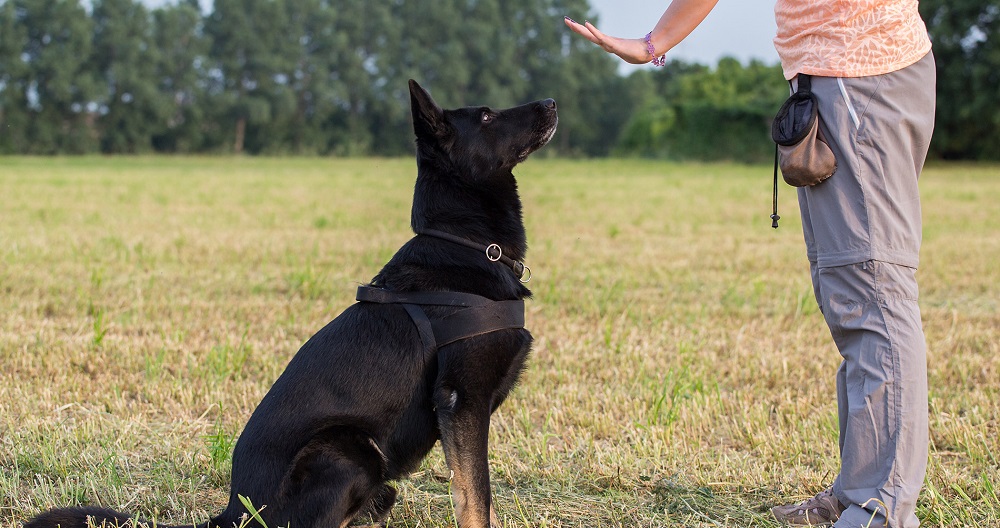Dogs are mankind’s best friends, but no one wants to put up with a canine who ends up eating the sofa or using the kitchen floor as his or her personal bathroom. That’s why responsible pet owners do everything in their power to make sure that their canine companions are well trained. And one way to do that is to make sure that you have the best dog training books at your disposal. We know because we’ve organized a collection of some of the best books on the subject below. Now no one has to put up with an unruly pet running their household.
Quick Summary of the Best Dog Training Books
- Editor’s Choice
Water Dog: Revolutionary Rapid Training Method (Amazon) – Review - Also Recommended
The Big Book of Tricks for the Best Dog Ever (Amazon) – Review - Also Consider
Lucky Dog Lessons: Train Your Dog in 7 Days (Amazon) – Review
Editor’s Choice: Water Dog: Revolutionary Rapid Training Method
Some people may be pass over this book once they’ve looked at its cover because they don’t feel it’s a training book that would apply to their pet, but that would be a big mistake. That’s because this dog training book is not only good for dog owners who want to train their retriever for retrieving ducks—as the cover of the book would imply—but is good for anyone who wants to train any dog breed for retrieving. Although it’s a book that was written to help train retrievers, it’s also a book that can be used for any dog.
This book was written by Richard A. Wolters, a Renaissance man who has worked as a photographer, atomic scientists, and a fine arts teacher, but is probably most notable for using the latest discoveries of animal behaviorists to craft one of the best dog training books to date. He originally wrote this book in 1964, but that shouldn’t deter the reader either because the information contained within it is just as important now as it was then.
It’s a book that will lay out the fundamentals of getting a retriever to retrieve ducks, shoes, or whatever else that needs to be retrieved. For some people, it might be a bit limited in scope, particularly for people who need to teach their dogs other tricks, but for hunters, this is the book to buy.
This book is designed for anyone who wants to train their dog to be obedient and well-mannered hunting tool that will provide the hunter with years of service. We do have to say that it does get bogged down a little bit into talking about which types of retrievers are best for which tasks, but that superfluous information doesn’t distract from the quality of the information contained within the book. Thankfully, it’s a book that’s isn’t very big, so the reader can retrieve the information contained within the book very easily.
Also Recommended: The Big Book of Tricks for the Best Dog Ever
Although there are plenty of dog training books that will give the dog owner a handful of tricks for their pets to perform, there are few books that are as detailed as this one. This book contains 118 tricks and stunts that the average pet owner can easily teach to their dogs. These include such tricks as rolling over, fetching, paw shaking, and ringing a bell to go out. There are also quite a few other tricks that might not be so practical; Tricks such as catching flying discs or having the dog perform dance routines.
This book was written by Larry Kay and Christ Perondi—two authors who know a thing or two about dog training. Mr. Kay is an award-winner writer based out of L.A who is the leader of the Positively Woof organization—an organization that celebrates the special bond that dogs and humans share. He has also written for Dog Fancy magazine and Paw Nation.
Mr. Perondi runs the Stunt Dog Academy in California and Stunt Dog Productions. You can find him and his wife performing thousands of shows across the country, from Dollywood in Pigeon Forge, Tennessee to Silver Dollar City in Branson, Missouri.
What makes this book exceptional, and helps it to stand out against some of the other training manuals out there, is that it not only has good information but also has a ton of pictures in it that help to drive the instructions home. This book has 320-pages and will help pet owners who have puppies and/or adult dogs.
However, the pet owner should keep in mind that many of the tricks and stunts found in this book might not be suitable for older dogs. That’s because some of these tricks and/or stunts may be physically demanding to mature dogs. If the reader keeps that in mind, however, we believe that this book will prove truly beneficial to them as they train their dogs.
Also Consider: Lucky Dog Lessons: Train Your Dog in 7 Days
Some people may recognize the author of this book, Brandon McMillan, from the CBS show Lucky Dog, where he’s the host. In this show, Brandon uses his unique training techniques to transform dogs into well-trained animals. It doesn’t matter if the dog has come from a shelter, or is a purebred puppy, in each episode he’s able to improve the dog’s behavior. And he’s taking all of that information and has placed it into this book: Lucky Dog Lessons: Train Your Dog in 7-days. A book that anyone can use to improve their dog’s behavior—regardless of whether it’s a puppy or an older dog.
This book begins with what many animal trainers consider to be the basics: the seven basic dog commands. These commands include sit, stay, come, off, heel, down, and no. Once he establishes how to train the dog these basic seven commands, he then moves on to solve some of the more common behavioral problems that dogs commonly have. These potential behavioral problems include barking excessively, dashing out the door, chewing up shoes and/or furniture, having bathroom accidents indoors, and begging for food during mealtimes.
Mr. McMillian just doesn’t go into information about training methods, however. He also explores the characteristics that make each breed unique and may potentially affect training. He talks about herding dogs, hounds, sporting dogs, terriers, working dogs, nonsporting dogs, and even toy breeds. He also goes into detail about how age and personality affect training.
If there are any complaints that we would have about this book or this author’s training methods, it’s the fact that many of his methods require the pet owner to use additional equipment that they may (or may not) have. This includes things such as having multiple leashes or dog training clickers. Of course, if the reader is willing to purchase these items (or if they already own them) and are willing to put in the training work with their dog, then this is a marvelous book to own.
A Guide To Using Dog Training Books Effectively
As we did our reviews of the best dog training books, we wanted to make sure that we covered a variety of different approaches, and we are happy with the results. We’ve tried to include books for dog owners who want to use their dog for hunting, books that helped dog owners train their dogs in various tricks, and books that helped people make their canine companion a better roommate. We feel that our readers could pick up any one of the above books (or all three) and end up using it to great effect.
Of course, it doesn’t do the dog owner any good if they buy the book and then don’t use it. This might sound obvious, but we know a lot of people who buy dog training books and think that some kind of miraculous transformation is going to happen in their pet just by them owning the book. Unfortunately, that isn’t how that works. The dog owner has to read, absorb, and then put the training tips into practice before they can transform their dog’s behavior.
This brings us around to why we’ve decided to write this guide. We wanted to give our readers a few additional tips that will help them get the most out of their dog training books—even if they don’t buy one of the books that we’ve suggested. The following general-purpose tips will help everyone who reads it to utilize their dog training books effectively to get the most out of them.
Step One: Read The Books Fully
One of the first things that the dog owner can do to get the most out of their training book is to read it from cover to cover before attempting to use it. A lot of people will pick up a book, skim through it, and then try to utilize the techniques contained within it and do it without fully understanding the principles behind the techniques.
Training books can be skimmed through so that the dog owner can pull out the techniques that they’re going to use for their pet, but it only should be done once they’ve gone through all of the material. That will help prevent false starts or improperly teaching the tricks to the dog due to a misunderstanding of the principles behind those techniques.
Step Two: Gather Any Tools Needed
The next thing that the consumer should keep in mind when using any dog training book for training their canine companion is to make sure that they have the tools they need for training before they start training. Although not all dog training books use additional tools for dog training, there are plenty of books that do. Some of the dog training tools that may be recommended by a training book include:
- Dog Clickers
- Collars And/Or Harnesses
- Additional Leashes
- Target Sticks
- Dog Crates
- Treat Pouches
- Chew Toys
- Portable Mat
- Baby Gates
Of course, even if the above training aids aren’t recommended by a particular book, many of them are helpful to have on hand anyway. Of course, that’s up to the dog owner and there’s been many a dog that’s been trained using only the pet owner’s attention to detail and perseverance.
Step Three: Be Persistent
Speaking of perseverance, that’s another thing that the dog owner is going to have to do to ensure that training is going to work. They’re going to want to make sure that they not only know and understand the techniques but also apply them consistently. Some dogs take longer than other dogs to learn a particular trick, so the dog owner is going to have to apply the training techniques regularly.
Step Four: Be Patient
Since it may take the dog awhile for their behavior to change or for them to learn a new trick, it’s important that the dog owner makes sure to be patient with their pet. This means not only being consistent with the animal but also not scolding the animal excessively. Be nice to your pet and show some patience, and your dog will be more receptive to the training process.
Step Five: Teach The Dog One Command At A Time
Yes, we understand that when a person gets a new dog training book they get excited and want to teach their pet all of the tricks in the book. Unfortunately, that’s not the best way to go about things. It’s better to teach the pet one trick at a time. Once the dog has learned that trick and can demonstrate it regularly on command, then the pet owner can move on to the next trick to be mastered.






























